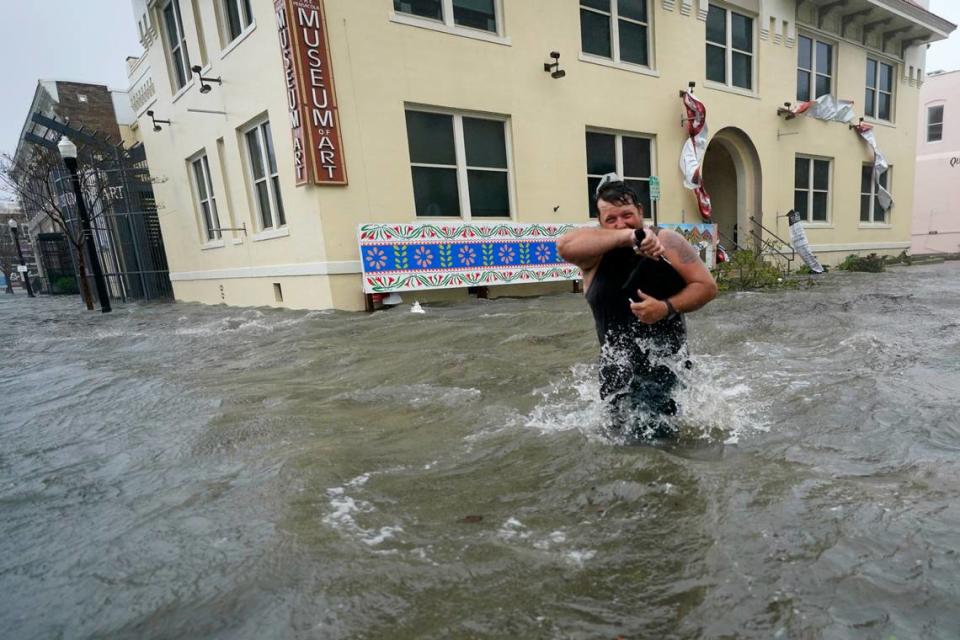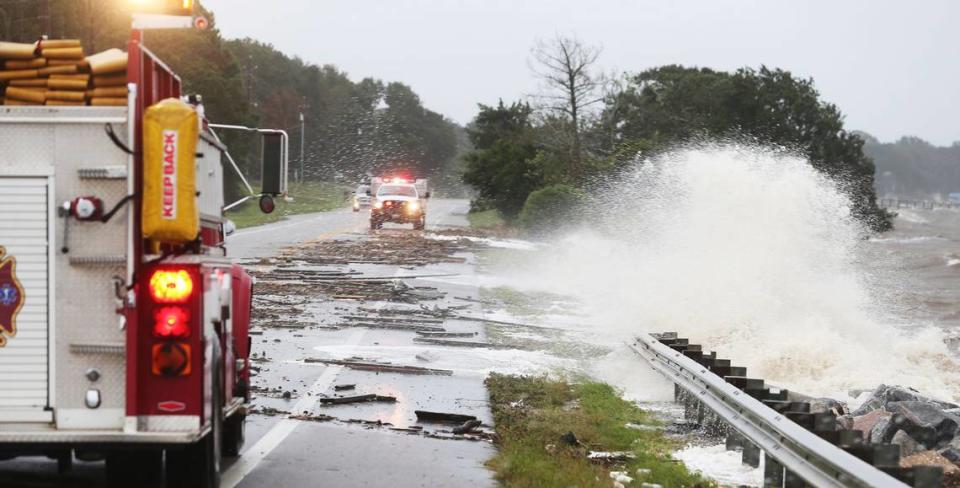‘Historic, catastrophic flooding.’ Florida Panhandle swamped by Hurricane Sally
A last-minute eastern wobble brought the Category 2 winds of Hurricane Sally — and at least two feet of rain — to the Florida Panhandle, leaving some communities awash under historic flooding they weren’t prepared for.
Although the storm made landfall in Alabama early Wednesday, it brought much of the worst rain and winds to Florida, lashing the coast from Pensacola to Panama City. The hurricane flooded dozens of roads, left more than 200,000 people without power and even led to water cutoffs in some places.
At an evening press conference, Florida Gov. Ron DeSantis said more than 600 search-and-rescue missions had been conducted, but they weren’t all for life-threatening situations. He said first responders reported two deaths but believed they were unrelated to the storm.
In Florida’s westernmost counties, Escambia and Santa Rosa, hurricane-force winds ripped roofs off homes and buildings, tossed boats onto land and even broke off a chunk of a brand new Three Mile Bridge in Pensacola.
But the real damage came from water. The storm surge came early, flooding parks on barrier islands and creeping into garages on Monday. By Wednesday morning, the Naval Air Station in Pensacola saw two feet of rain and NOAA recorded nearly six feet of storm surge, enough to submerge much of downtown. Murky seawater reached the wheel wells of cars and swamped the first floor of buildings and homes.
“When you hear things like historic, catastrophic flooding ... the National Hurricane Center isn’t necessarily right on everything, it’s a tough business, but they don’t choose those words lightly,” DeSantis said. “There is going to be a lot of property damage.”
DeSantis also warned that although the rain had lessened as Sally headed northeast, rain dumped on states like Georgia would swell Florida’s rivers and possibly cause more flooding later in the week.
“This is kind of the initial salvo, but there is going to be more that you’re going to have to contend with,” he said. “People need to buckle up if they’re in those areas.”
The state sent 50 highwater vehicles, 60 troopers from the Florida Highway Patrol, 175 generators and 100 water pumps to the region, and DeSantis said 60,000 gallons of drinking water should arrive Wednesday night for communities where the storm burst a water main.
Lt. Col. Blake Heidelberg, a Florida National Guardsman helping local authorities with the search and rescue effort, said the majority were in Escambia and Santa Rosa County. By far, most people calling for help had trees or floodwaters blocking their neighborhood and needed assistance getting to shelters.
“There were extreme cases where one-story homes were flooded and people were saying they were going to their attic,” he said. “But that was the exception to the rule.”
Heidelberg said they’re still waiting for the rivers to crest and potentially cause more flooding, but in the meantime the National Guard is distributing water, tarps and meals ready to eat.
“We can also do a lot of route clearing, debris removal. It’s something we take a lot of pride in,” he said. “It really makes a difference.”
Officials in the hardest-hit counties expressed shock on Wednesday at the destructive power of Hurricane Sally, which they thought was on track to largely spare Florida.
“I think many of us were beating ourselves up first thing this morning because the reports that we had gotten from the National Weather Service, etc., led us to believe that while we would certainly have some impact from this storm, it would not be a direct hit on Escambia County, and it certainly wouldn’t have the devastating effects that we’re experiencing right now,” Escambia County Sheriff David Morgan said during a county press conference Tuesday morning, the Pensacola News Journal reported.
Escambia, Santa Rosa, Okaloosa and Walton Counties opened a single hurricane shelter each ahead of the storm, although Escambia was the only county to order voluntary evacuations to the most at-risk residents.
The shelters screened evacuees for COVID-19 symptoms and offered them masks. People with symptoms or who were confirmed COVID positive were sheltered in hotels paid for by the state.
DeSantis noted that additional river flooding may send more people to shelters in coming days.
Storms coming to Miami? Saltwater flooding in the Keys? Here’s what the forecast says
Miami Herald Staff Writer Michelle Marchante contributed to this report.






